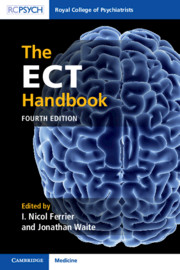Book contents
- The ECT Handbook
- The ECT Handbook
- Copyright page
- Contents
- Contributors
- Preface
- Chapter 1 The Place of ECT and Related Treatments in Contemporary UK Psychiatry
- Chapter 2 Mechanism of Action of ECT
- Chapter 3 ECT in the Treatment of Depression
- Chapter 4 ECT in Mania (and Mixed States)
- Chapter 5 Electroconvulsive Therapy in Bipolar Disorder Depression
- Chapter 6 ECT in Older Adults
- Chapter 7 ECT in People with an Intellectual Disability
- Chapter 8 ECT in Pregnancy and Postnatally
- Chapter 9 Electroconvulsive Therapy in Children and Adolescents
- Chapter 10 The Use of ECT in the Treatment of Schizophrenia
- Chapter 11 The Use of ECT in the Treatment of Catatonia
- Chapter 12 ECT in Neuropsychiatric Disorders
- Chapter 13 Cognitive Side-Effects of ECT
- Chapter 14 Non-cognitive Adverse Effects of ECT
- Chapter 15 Transcranial Magnetic Stimulation
- Chapter 16 Neurosurgery for Mental Disorder
- Chapter 17 Ketamine for Psychiatric Disorders
- Chapter 18 The ECT Accreditation Service (ECTAS)
- Chapter 19 The Scottish ECT Accreditation Network (SEAN)
- Chapter 20 Medical Training for Psychiatrists in ECT
- Chapter 21 Nursing Care of the Patient Receiving ECT and the Roles of the ECT Nurse
- Chapter 22 Practical Aspects of ECT
- Chapter 23 Anaesthesia for Electroconvulsive Therapy
- Chapter 24 Dental Issues Related to ECT
- Chapter 25 Interactions between ECT and Prescribed Medication
- Chapter 26 Seizure Monitoring in ECT
- Chapter 27 Safe ECT Practice in People with a Physical Illness
- Chapter 28 Capacity, Consent and the Law
- Chapter 29 Patients’, Carers’ and the Public’s Perspectives on ECT and Related Treatments
- Index
- References
Chapter 22 - Practical Aspects of ECT
Published online by Cambridge University Press: 27 June 2019
- The ECT Handbook
- The ECT Handbook
- Copyright page
- Contents
- Contributors
- Preface
- Chapter 1 The Place of ECT and Related Treatments in Contemporary UK Psychiatry
- Chapter 2 Mechanism of Action of ECT
- Chapter 3 ECT in the Treatment of Depression
- Chapter 4 ECT in Mania (and Mixed States)
- Chapter 5 Electroconvulsive Therapy in Bipolar Disorder Depression
- Chapter 6 ECT in Older Adults
- Chapter 7 ECT in People with an Intellectual Disability
- Chapter 8 ECT in Pregnancy and Postnatally
- Chapter 9 Electroconvulsive Therapy in Children and Adolescents
- Chapter 10 The Use of ECT in the Treatment of Schizophrenia
- Chapter 11 The Use of ECT in the Treatment of Catatonia
- Chapter 12 ECT in Neuropsychiatric Disorders
- Chapter 13 Cognitive Side-Effects of ECT
- Chapter 14 Non-cognitive Adverse Effects of ECT
- Chapter 15 Transcranial Magnetic Stimulation
- Chapter 16 Neurosurgery for Mental Disorder
- Chapter 17 Ketamine for Psychiatric Disorders
- Chapter 18 The ECT Accreditation Service (ECTAS)
- Chapter 19 The Scottish ECT Accreditation Network (SEAN)
- Chapter 20 Medical Training for Psychiatrists in ECT
- Chapter 21 Nursing Care of the Patient Receiving ECT and the Roles of the ECT Nurse
- Chapter 22 Practical Aspects of ECT
- Chapter 23 Anaesthesia for Electroconvulsive Therapy
- Chapter 24 Dental Issues Related to ECT
- Chapter 25 Interactions between ECT and Prescribed Medication
- Chapter 26 Seizure Monitoring in ECT
- Chapter 27 Safe ECT Practice in People with a Physical Illness
- Chapter 28 Capacity, Consent and the Law
- Chapter 29 Patients’, Carers’ and the Public’s Perspectives on ECT and Related Treatments
- Index
- References
Summary
The Royal College of Psychiatrists recommends that a specially designated space for ECT treatment should be available (ECTAS, 2018). As the number of patients being referred for ECT continues to decline (Buley et al., 2017) the availability of ECT for patients who require it may be compromised. The College ECT Committee is supportive in helping clinics to find alternative treatments for depression which may be delivered in the ECT centre. A number of centres already provide additional services to ECT, for example clozapine and depot clinics. ECT clinics are also used for the delivery of rTMS (Chapter 15) and ketamine infusions (Chapter 17).
- Type
- Chapter
- Information
- The ECT Handbook , pp. 183 - 201Publisher: Cambridge University PressPrint publication year: 2019
References
- 2
- Cited by



